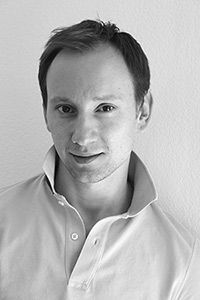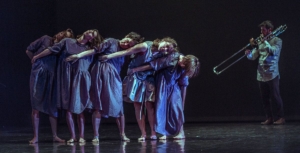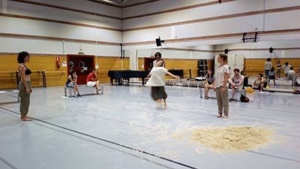Residencias de Creación
2016/2017
THE COMPAÑÍA NACIONAL DE DANZA LAUNCHED ITS THIRD CALL FOR CONTENDERS IN ITS CREATION RESIDENCY INITIATIVE (RESIDENCIAS DE CREACIÓN).
This initiative aims to facilitate emerging choreographers a space in which to work and experiment while promoting their creations through the communication platforms put at their disposition.
Coreógrafos invitados
-
Iker Murillo
NOCTURNE
Choreography: Vitali Safronkine
Music: F.Chopin
Dancers: Christina Casa y Iker MurilloSinopsis: Después de 6 años creando para Covent Garden Dance Company, Vitali llevará una pieza única, inspirada en la belleza de los jardines Ingleses. En la creación de este año, la brisa que fluye a través de las rosas y las notas de Nocturne de Chopin, guiarán los cuerpos en movimiento hacia el anochecer.
Iker Murillo

Iker Murillo
Dancer and Artistic Director at Uniqart Dance Company. Mr. Murillo was born in San Sebastian, Spain and at fifteen years old he moved to Madrid in search of competitive dance training.He entered the distinguished “John Cranko Ballet School” in Stuttgart, Germany from which he later graduated.
His professional dance career launched in 1997 as a “Soloist” with the “Saarländischen Staatstheater”, and in a quest to expand his repertoire he later joins the “Heinz Spöerli’s Zürich Ballet” in 2001 where he performed various breathtaking roles alongside world-renowned choreographers.
His journey led him to the “Richard Wherlock’s Basel Ballet” until 2012. Since then, he has been touring and performing on famous stages worldwide with “The Béjart Ballet Lausanne”.
Mr. Murillo’s unique trajectory of 17 years has merited him several mentions in the acclaimed “Ballettanz Magazine”: 2002 “Young Dancer to watch”, 2008 “Outstanding Dancer”, and “Dancer of the Year” in 2010.
He received the “Dance Revelation” award in 2008 by “The Professional Dance Association of Gipuzkoa”.
In 2012 he performed for the president of the Basque country.Vitali Safronkine

Resident choreographer at Uniqart Dance Company.
Mr. Safronkine was born in Samara Russia and began his dance training at the “Rudolf Nureyev Ballet School“ and at the age of 15 he left his native country to advance his training at the “Swiss Professional Ballet School“ (SBBS) in Zürich.
He is a recipient of “The Nureyev Foundation“ scholarship and achieved a finalist position in the world-renowned ballet competition “Prix de Lausanne“ in 2002.
That same year he won the “International Kiev Ballet Competition“ in Ukraine.
His professional career launched in 2004 with the “Heinz Spoerli’s Zürich Ballet“ where he reached the rank of “Soloist“ until 2010.
Eager to evolve and grow in his neo-classical repertoire, Vitali joined the “Richard Wherlock’s Basel Ballet“ in 2011.
In 2012 he continued his career at the “Béjart Ballet Lausanne“ where he not only expanded his repertory with various challenging roles, but also premiered as a choreographer by staging his timeless ballet “Reflejos” in June 2013.
Since 2008, Vitali has produced over 14 original choreographies for established ballet companies, while fulfilling his obligations as a dancer.
His breathtaking works have been performed in International Ballet Galas as well as in professional ballet competitions. Additionally, he has shared his passion for creating ballets with several ballet schools in Europe.
As a 2013 nominee of “A New Name to Watch“ by Dance Europe Magazine, this unique entrepreneur is continuously looking to expand his horizons as a dancer and choreographer.
In 2016 Finalist of the Emergent Choreographic Competition in Biarritz, organized by the Malandain Ballet and Bordeaux National Opera.Iker Murillo Director Artístico Uniqart Dance Company
-
Lucio Baglivo
SOLO JUNTOS
Choreographer: Lucio Baglivo, with contributions from Candelaria Antelo and Maximiliano Sanford
Dancers: Candelaria Antelo, Anuska Alonso, Maximiliano Sanford, Lucio Baglivo
Wardrobe: Lucio Baglivo
Collaboration: Soledad OviedoLUCIO BAGLIVO
LUCIO BAGLIVO
With his experience as actor, dancer, dance teacher and artistic director, the objective of Lucio Baglivo’s dances is to transmit emotions and connect with the spectator by enhancing the stage’s entire range through dance, acrobatics and theatre. Each project seeks its own language of movement and a uniquely staged poetry.
-
Alejandro Moya
LUCERO DE LA MAÑANA
Choreographer and Dancer: Alejandro Moya
Choreographic Assistant: Miguel Ballabriga
Photography: Miguel Ballabriga
Musical Montage: Juan Crespo
Video: Victor Pajares
Lighting Design: Beatriz FrancosINTRODUCTION
A dance solo inspired by both the Spanish copla song form and bullfighting; a homage to Antonio Molina and the toreros.
The dancer develops his sentiment and expression through the musical drama. The performance is punctuated with silences. There, within those silences, the language undergoes variations and the dance strolls through different physical phases. Everything combines to compliment the fundamental idea of expression; yet it is also made more distant. The piece works on different poetic words from the copla, emphasising and transmitting them in highly pronounced expressions.
The piece is a ceremony where the dancer, in torero tradition, calls upon the morning star—the “Lucero de la mañana”—to shine good luck down on him.
Entering the stage, fragile but protected by his cape, he prepares the way for the first scene: a dream; a fantasy. The dream is “La Rosa del Penal”, a milonga dance of 1957, composed by Arroyo Benito and sung by Antonio Molina.
On waking, he is disorientated; he wants to ask his morning star for luck but he cannot find it among the confusion of other lights. He enters into spirals that sway back and forth throughout the stage space until his cape finally stops his feet. Thwarted and sad, he slowly starts trying to escape his internal dilemma. It is then that the morning star starts to shine on him and he is able to finish his ceremony.
This final scene is performed with the words from “Lucero de la Mañana”- Tientos de Perelló y Montorio.
The piece includes the same words of Ángela Molina that helped inspire it. Those words, taken from an interview on the programme Cantares, are about Spanish popular song:
“It is one of the most authentic forms of expression that we have. It’s a song form that’s with us in our bad times and our good times. It has always been a part of us; of our origins.
“As a song form, it is a weapon and a reward at the same time and with which we plead fairness, with which we offer our love, with which we get closer to each other; it is a part of us.
“I think we owe it to ourselves to be constantly aware of our roots and to value them and treasure them. To feel our connection with them has its place; it has a meaning; a raison d’être.” -
Otradanza
PÉLVICO
Pélvico (Pelvic) is a contemporary dance piece which, far from avoiding stating the obvious, highlights it. It is a work conceived, choreographed and danced by women. It is not about woman but is born of woman. The body, its structure and its movement are the premise; a body of that sex exploring its properties as a gender.
Artistic director and choreographer: Asun Noales
Dancers: Saray Huertas, Diana Huertas, Carmela García, Asun Noales
Lighting design: Asun Noales / Richard Cano
Archives: Francisco Sarabia Marchirán
Wardrobe design: OD
Music: Various Composers
Photography and video: Germán Antón
Graphic design: Los Machos
Musical advisors: Germán Antón y Francisco Sarabia Marchirán
Sound: Eurotrack Estudio
Technical director: Richard Cano
Communications: Francisco Sarabia Marchirán
Executive production and distribution: Amadeo Vañó – Cámara Blanca
Residency: CCCE L’Escorxador -
Tangen Benzal
Guest choreographers
Idea, choreography and dancer: Jesús Benzal y Ole Kristian Tangen
Date and venue of premier: 28 April 2017 in Dansens Hus, Oslo – Norwegian National Theatre of Contemporary Dance
Wardrobe: Trude Amalie Leirpoll
Collaboration: Camille Balcaen, Clàudia Bosch, Irene Rubio
Duration: 15-25 min.
SYNOPSIS: The action takes place in a lonely bar along an old road, now by-passed and practically in disuse. The strange sedentary regulars somehow keep the inn going, precariously breathing thin life into the place. We see how each customer is living on the brink of oblivion; an existence where nothing lasts. All is ephemeral, even the repeated anecdotes and tales. All can be won and then lost in an instant. In this small community, each person’s routine loneliness is confronted with the unwanted arrival of the predictable; and it is from here that the piece unfolds.
-
Plataforma DISPLACED
DISPLACED
A choreographic platform created by two dancers: Joana Brito and Wody Santana
Artistic director: Wody Santana
Choreography: Wody Santana / Joana Brito / Valentina Pedica
Dancers: Wody Santana / Valentina Pedica / Joana Brito
Lighting design: Israel G. López –Torrecilla Santana
Displaced was an almost spontaneous creation, born of the strong artistic and personal connection between its creators; two people displaced by circumstance from their home country. Each feels a burning need to transmit a language of their own and tell their own story in that language. Their creative process sprouts strongly from their Portuguese-Brazilian roots. Special attention is paid to the sophistication of movement; a contagious process which develops into meticulous care paid to the slightest detail throughout the cast. To a large degree their working method is based on collaborations with artists from home and abroad from different artistic branches. That enables DISPLACED to generate versatile, creative and powerful works of art.
Within the context of the CND residency, DISPLACED will continue working with the piece “Nuvem Congelada”. It has already participated in different festivals, contests and other events with this piece, which now forms part of its 2017 agenda. In parallel, DISPLACED will start a creative process with a new project: “Rapsodia”. The platform already has performances scheduled for this piece, which is also likely to form part of a project between Portugal and Spain.Rapsodia

(Rhapsodies existed in ancient Greece when a rhapsode took a part of a Homer poem, reciting it and leaving the rest of the verses aside. In music, a rhapsody comprises freely joining different rhythms and themes that have no clear connection with each other).
Rhapsody is the joining of fragments of different ideas. We stepped out to take on a creative process that, at its base, has the idea of the inspirational or motivational void that the artist faces on taking on the process to create; and we transfer this idea to explore what it means in our daily lives. What is this search for motivation and what is it for? What are we expecting? What inspires us? Why do we need inspiration? As a reference, we turn to the works “Waiting for Godot” by Samuel Beckett, “El Exilio de Gardel” by Fernando “Pino” Solanas and “Six Characters in Search of an Author” by Luigi Pirandello. All of those works represent that ‘absurd’ void. We have conceived the creation for three or four dancers in a hotel on New Year’s Eve. Because of the times, a forced partying atmosphere prevails, rather than one of spontaneity. And as the night unfolds the characters reflect on the year that is about to end and they excitedly guess on what the coming year has in store. With minimalistic artistry and theatrical farce, the dancers develop and embody the existentialist and pathetic discourse on their fears and frustrations, their “lack of life”, their nostalgia for when they dreamed of adventure. -
La Phármaco
MISERERE
Artistic director: Luz Arcas
Distribution and production: Julia Sueiro
Since its birth in 2009 La Phármaco has aimed to revive the classical concept of scenic ceremony, in which expressive elements are brought together in the same tone and committed to the same message, all focussed on the human experience. La Phármaco believes that dance is not restricted to matters of either genders or style. Rather it believes its duty is to make visible all that was shrouded in darkness and to celebrate scenic ceremony as a necessary social and humanistic mechanism capable of conversing with the fundamental voices of our culture and our history.
Miserere. “Cuando la noche llegue se cubrirán con ella” (“When night comes it will bring cover”) is a piece for five dancers with live music, specifically piano, wind instruments and voice and with an innovative use of stage space and video.
Choreography: Luz Arcas
Dramaturgy: Abraham Gragera
Artistic director: Luz Arcas
Distibution and production: Julia Sueiro, Sofía Manrique, La phármaco
Dancers: Raquel Sánchez, Begoñóa Quiñones, Ana Catalina Román, Nadia Vigueras, Elena González-Aurioles
Musical composition, piano and positif organ: Calos González
Voice: Laura Fernández
Wind instruments: Cristian Buades
Photography and video: Virginia Rota
Graphic design: María Peinado Florido
Wardrobe design: Heridadegato
Lighting: Jorge Colomer -
Alejandro Lara
PUJANZA
SINOPSIS: PUJANZA is a Spanish dance project displaying Spanish dance pure and simple; no thrills or spills, just its different accents, its brio movements and its art.
This project aims to take advantage of the few opportunities that young people who have trained in Spanish dance have to show their technical and artistic talent.
Premier date: The creation PUJANZA will be premiered in full on Saturday 27 May 2017
Acknowledgements and thanks to: Each of the dancers forming part of this project.
The Compañía Nacional de Danza, the `Mariemma´ Royal Professional Dance Conservatory and and Rafael Aguilar’s Ballet Teatro.
-
Iratxe Ansa
POINT OF CLARITY
CONCEPT: Our point of departure will be pure physicality, building on the choreographic material developed during our travels this past year to ten different countries around the world, collaborating with an array of dancers and artists. We wish to remain open, without restrictions or barriers, to discover where our creativity will lead us.

-
Natalia Fernándes
ANATOMY AND STRATEGY
“Anatomía y Estrategia” is the title of Natalia Fernandes’ solo, which won the Me, Myself and I category award in 29th Choreography Contest of Madrid (Certamen Coreográfico de Madrid).
The solo suggests a close and vehemently critical look at the relationship humans have with their environment. It reflects, in a non-too-obvious way on the strategies our bodies build to tackle the boundaries between reality and human rationality.
What is the relation between our bodies and the lines of reason drawn by our century? Where does the nature of our bodies begin and end? How do we control the defining lines? When do we lose control?
ANATOMY-DESNATURE STUDIES
As the result of an artistic collaboration between Natalia Fernandes and two resident artists in Madrid—Isabela Rossi and Dakota Comín—the project “Estudios para la Anatomía–La Mujer” (Studies of the Anatomy—Woman)marksa first step towards trying to access our contemporary thought, with all our questionings and behaviours, through the muscles, bones and organs.
“The body is thought and so therefore body movement is the movement of thought.” That reasoning is the base and motor of Natalia’s physical work in this investigation, with thought and motion being a source of reciprocal action. n this first study, focused on the subject of woman and her anatomy, the dancers explore feminine thought and doubts and desires through the possibilities and limits marked by her anatomy.

Creation by Natalia Fernandes
Dancers: Dakota Comin and Isabela Rossi (Estudios para Anatomia – La Mujer), Natalia Fernandes (Anatomia y Estrategia)
Music: Rodrigo Ramos
Lighting: Pablo Seoane
Images and Video: Agustína Arán
Projected Text: Poema from ´Livro da Dança´ (‘Book of Dance’), by Gonçalo M Tavares
Teaser: Marlene González, Jonatan Doblado, Yaina Llano
With the collaboration of: Jeronimo Bittencourt, Clarissa Sachelli, Barbara Faustino, Gonçalo M Tavares, Isabela Rossi, Dakota Comin, Natalia Mendonça, Goncalo Marcelo
Research consulting: Bruno Dahia (Ph.D in International Law)
Acknowledgement and thanks to: 29th Choreography Contest of Madrid (Certamen Coreográfico de Madrid), Pasoa2, Musibéria, Rua das Gaivotas, Teatros Canal/Centro de Danza Canal, Compañía Nacional de Danza, Choreographers en Comunidad-Conde Duque and Valdo.
BIOGRAPHY
Natalia Fernandes is a Brazilian dancer and choreographer who has been living between Madrid and New York since 2015. She studied dance at the Campinas State University in Brazil. Her career includes, mainly, work as a dancer for a number of companies and choreographers in Brazil, Europe and USA. As a choreographer herself, she has worked since 2014 in different countries and has been researching different cultures across Germany, Brazil, Jordan, Spain, Portugal and Morocco. Her project ‘The Oldest Thing in the World´ received the support both of the American Language Center in Tangiers and of the American Legation Museum in Tangiers.
This project includes a fragment of the solo ´This is Not Mine´. This solo has been performed at various different festivals and theatres across Europe, Africa and the Americas since 2015. Natalia was invited as choreographer by Madrid’s Laboratorio 180 company to work on the project ‘Anatomía y Estrategia I ´.
In 2016, Natalia was an award winner in the 29th Choreography Contest of Madrid (Certamen Coreográfico de Madrid) within the Me, Myself and I category, for her solo version of ‘Anatomia y Estrategia ‘ and recieved the support of the Pasoa2 team to carry out the creative work on that solo.
Natalia is also the project director for the ongoing development of the piece ‘Estudios para Anatomia – La Mujer´, working with other artists in Madrid. She is a teacher of contemporary dance in Carmen Senra’s BambuDanza school. Additionally, she is carrying out a project of body awareness and contemporary dance for refugees together with the Spanish Commission for Refugee Aid (CAER) in Madrid. -
Carmen Fumero y Miguel Ballabriga 16/17
EL PASILLO SIN NÚMERO
Directors and choreographers: Miguel Ballabriga and Carmen Fumero
Dancers: Miguel Ballabriga and Carmen Fumero
Lighting design: Sergio García
Lighting technician: Beatriz Francos
Music: This Day In
SYNOPSIS: A woman, in a hurry, returning from a place she’d rather not talk about and on her way somewhere to meet somebody. She carries a feeling about her related to what has happened. The path ahead is long, almost interminable, and is like an extensive corridor lit by old lamps.
“If memory could be canned, I would prefer it didn’t have a use-by date”
“Chungking Express” by Wong Kar-Wai
Premier: Cuadernos Escénicos Festival, Garachico-Tenerife, July 2017.
-
Muriel Romero
The Marriage of Heaven and Hell (El Matrimonio del Cielo y el Infierno)

SINOPSIS:The Marriage of Heaven and Hell is a choreographic piece based on the book of the same name by Willian Blake. The piece combines dance, electro-acoustic composition, interactive technology and cognitive sciences.
The central core of Blake’s original work is the joining together of two apparently irreconcilable opposites. Specifically, there is the virtuous clarity of rational techno-scientific thought (heaven, logos) and its opposite; the possessed and relentless creative forces of both imagination and instinct that arise from bodily energy (hell, mythos).
The joining of these two opposite and seemingly opposing poles takes place on stage with the coupling between bodily activity and technological abstraction as two complementary aspects of the same multidimensional interactive reality. The piece explores and analyses the different qualities inherent in body movement, such as energy, fluidity, symmetry and impulsiveness. Those qualities are translated, in real time, into abstract digital sounds and visual effects, enhancing the reality of the dance and turning the stage space into a reactive setting emanating the body expressions of the dancers.
One of the objectives of this exploration is to use interactive technology as a means to amplify body awareness and to renegotiate the limits of physicality. Here, the dancers’ and chorographer’s activity takes on a cognitive function, using metaphor together with sculpted visuals that are somatosensory and tactile and engage cerebral-motor reaction while generating new forms of movement. This cognitive model of the body directly connects with Blake’s Marriage of Heaven and Hell; a visionary piece of work that breaks through the barriers between artistic imagination and rational thought, body and psyche, metaphor and concept.
Choreography: Muriel Romero
Music: Pablo Palacio
Dancers: 5 dancers. Casting still to be determined
Software and Interactive Technology: Daniel Bisig, Pablo Palacio and Infomus Casa Paganini
Lighting: Juan Antonio Casado
Wardrobe: Nicholás & Atienza
Production: Instituto Stocos
Supporters: University of Navarre, Compañía Nacional de Danza, Teatros del Canal, EU ICT H2020, Hebel Halle (Heidelberg, Germany), Infomus-Casa Paganini- University of Genoa (Genoa, Italy) and Institute for Computer Music and Sound Technology of Zurich (Zurich, Switzerland)




















